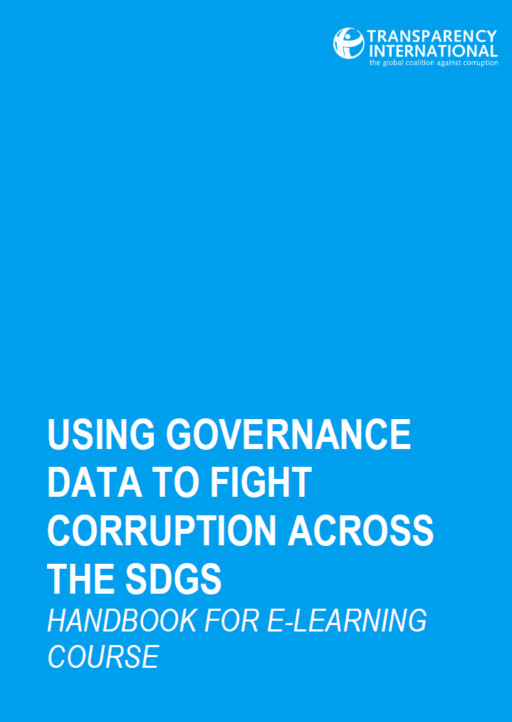Using governance data to fight corruption across the SDGs: Handbook for e-learning course
Description
This handbook has been produced to accompany an e-learning course entitled Using Governance Data to Fight Corruption Across the SDGs.
With the launch of the Sustainable Development Goals, we have a precious opportunity to push for real improvements in governance around the world. With the development of this course, Transparency International is seizing this opportunity with both hands. Our ambition is to inspire a new generation of governance-related data projects that can help diagnose the causes and effects of corruption, advocate for further anti-corruption efforts, and monitor the effectiveness of these efforts.
This handbook contains the scripts for all of the videos in this course. Learners can refer to the handbook throughout the course, using it as a resource to accompany and support their study.
The Problem
Data is key for understanding and tackling corruption. But how much do we really know about the scale, nature, and cost of corruption? Is it possible to measure its impact on people? Can we make meaningful comparisons of corruption between countries? How do we monitor corruption trends overtime?
Data can help answer these questions and give us the means to drive policy reform. When used effectively, governance data can be a powerful tool to inform citizens, influence decision makers and track the progress of anti-corruption interventions.
However, working with data can seem intimidating. So, Transparency International - in partnership with Kemitraan: the Partnership for Governance Reform and Leiden University - has created an e-learning course to equip learners with the ideas, skills and knowledge to rise to the challenge. Ultimately, our hope is that the new proficiency in the use of governance data that learners develop will allow them to produce the kind of evidence-based advocacy that drives change in the real world.
The Approach
This course aims to equip learners with the knowledge and the skills needed to collect, analyse and use governance data to monitor corruption and promote anti-corruption reforms across the SDG framework.
The structure of the course is as follows:
- First, we explore the value of working with data for anti-corruption initiatives, as well as the opportunities presented by the SDGs and the "data revolution".
- Then, we guide students through the first steps of working with data: defining their research objective, identifying data needs, and figuring out whom to engage, how, and at which stage of the process.
- After this, we learn how to identify strategic indicators that best match our objectives, and how to develop so-called ‘baskets of indicators’ to capture a fuller picture of the progress of anti-corruption reforms.
- Next, we discover how to match our chosen indicators with the most relevant data sources, and assess the reliability of various datasets.
- Then, we look at how to develop advocacy strategies to maximise the policy impact of our data.
- Finally, we consider how to employ governance data to monitor and tackle corruption across the SDG framework.
Authors
Matthew Jenkins and Marie Chêne, Transparency International
Marie Laberge, independent governance expert
Inda Loekman, Kemitraan: the Partnership for Governance Reform
Date
30/08/2018
Tags
 Download PDF
Download PDF
